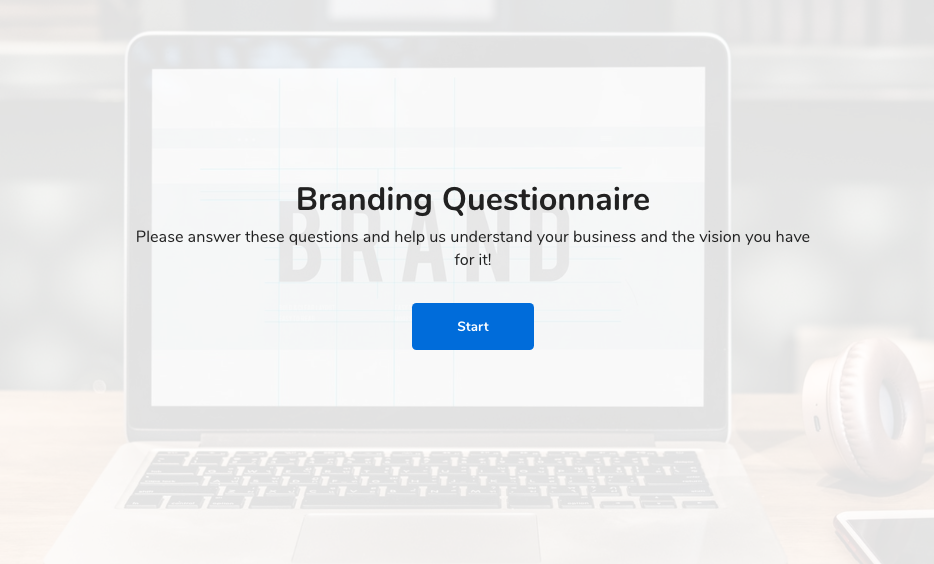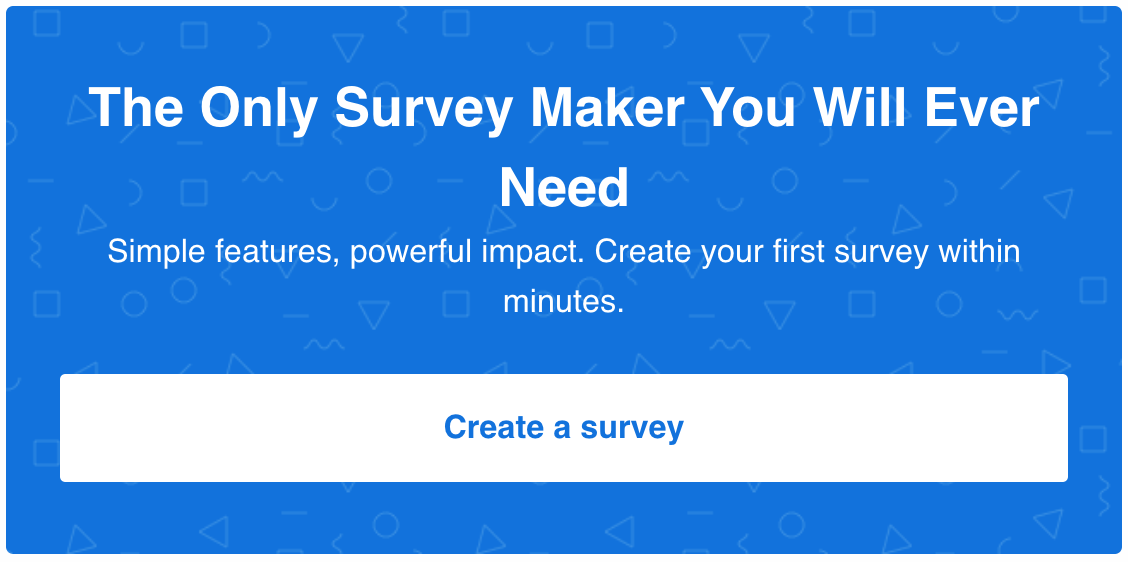Branding and brand awareness are often downplayed in the world of marketing. There are two main reasons for this. First, branding takes time and its results are not immediately visible and measurable. This is why marketers and agencies tend to prioritize classic advertising and marketing campaigns.
Second, many marketers don’t know how to come up with a viable strategy. Sometimes, the reason for that are clients who don’t know what they want or how to define their business.
Anyway, before doing any substantial work on your branding, you need to determine whether and how popular your brand is among consumers right now. That will make your subsequent branding efforts much easier both to implement and monitor.
In other words, the first thing you need to do is run a survey (we’ll give you the template right away). If you’re a marketing agency working on branding for a client, you’ll also want them to complete a branding questionnaire (scroll down to get this template too).
Brand awareness survey template
To help make sure you get the right idea about how popular your brand is among consumers and determine the true reach of your brand, we have created this survey template you can use right away or easily customize to your liking.
*To access the template, just create an account (or login), and then select a template from our builder.
Before we move on to branding mistakes and give you another free template (branding questionnaire), let’s first briefly examine the importance of brand awareness and define what constitutes good branding.
Why exactly is brand awareness so important?
Business Dictionary defines branding as “the process of creating a unique name and image for a product in the consumers’ mind, mainly through advertising campaigns with a consistent theme.”

The purpose of branding is to “establish a significant and differentiated presence in the market that attracts and retains loyal customers.” High-quality branding has been proven many times to be very good at all of these things.
Take a look at some of the most impressive branding-related stats:
- 59% of consumers prefer to purchase from familiar brands
- Loyal customers can be worth 10 times as much as a one-time customer
- Consistent branding increases revenues by up to 23%
- A 2% increase in customer retention can lower costs by as much as 10%
- 63% of consumers said they’d think more positively about a brand if it provided them with more valuable, interesting or relevant content (Rapt Media)
- 43% of people are more likely to purchase a new product when they have learned about it through social channels, while 77% of buyers see the advice of family and friends as the most persuasive when looking to learn about new products (Nielsen)
Despite these numbers, small and mid-size businesses often fear to tread into branding territory. Whether it’s the website cost, marketing agency fees, or the time and effort you personally invest, serious branding can require significant resources.
In fact, for most of us, branding feels like something that belongs exclusively to well-established giants in their respective industries, such as Nike, Coca Cola, Chanel, etc.
However, keep in mind that all of these brands had to start somewhere. Their immaculate brand is a product is a result of decades of consistent branding strategy. If you want to see how Nike did it, click here. But before that, stick around a bit longer and focus on the mistakes you should avoid.
Let’s now look into some of the most common branding mistakes. After that, we will show you how a simple branding questionnaire can save you a lot of time and effort and help you prevent some of these mistakes.
5 Common Branding Mistakes
The image of a “brand” as an exclusive asset of the industry giants often negatively affects the way both business owners and marketers think about the process of branding from scratch. This often results in these branding mistakes.
1. Shallow approach
When somebody says Nike or Coca Cola, it is highly likely that the first mental image you’ll have is their logo or particularly good advertisement. This is great – it means their branding strategy is working. However, it often tricks business owners and marketers into thinking that a recognizable, flashy logo or a powerful motto is all there is to it.
 Are we done yet?
Are we done yet?
They feel that brand building starts and stops at finding the right colors and design and slapping it on every product. While visuals are a prerequisite to making your product widely recognizable, branding constitutes more than that.
These visuals and branding messages have to be in line with every aspect of the business – which leads us to the next common mistake.
2. Lack of commitment
Business owners and marketers who believe that branding comes down to a logo and catchy message also tend to think that branding is only a matter of marketing team.
In fact, branding has to be intertwined with every aspect of the business. The way you sell, the way you create or deliver the product, the way you communicate with customers, the way you handle problems – all of these things are part of branding.
Your branding message and mission statement have to be reflected in every aspect of your business. This requires a detailed marketing strategy – and most businesses have been traditionally bad at coming up with a detailed, all-encompassing marketing plan.
 Source: CoSchedule
Source: CoSchedule
According to a CoSchedule survey conducted among more than 3,000 marketers from 100 countries, only 16% of marketers fully document their marketing strategy.
3. Lack of self-awareness
This one may not be easiest to communicate to a client, but it is a common pitfall of branding that needs to be addressed. We all like to imagine we are the smartest, the strongest, and the bravest. Since businesses are run by people, the way entrepreneurs and management think about their business tends to be similar.
Many brands see branding as an opportunity to portray themselves in the best light which doesn’t necessarily reflect the real state of things. So, is your branding message reflecting who you are, or who you want to be?
Good branding takes into consideration businesses’ good and bad sides and seeks to capitalize on good ones. Some brands, such as RyanAir even capitalize on their flaws by masterfully flipping the narrative. Their message is: yes, we know our service is terrible but you’re flying for $20 and this is what you get for that money.
 RyanAir: Things you can get away with for being cheap.
RyanAir: Things you can get away with for being cheap.
Another common mistake connected to the lack of self-awareness is desperate need to be quirky and different for the sake of it. Many businesses thus fail to reach their target market because their branding messages easily turn into caricatures.
4. Broad branding
Every business wants to have as many customers as possible. Most of them are able to reach several target markets. However, going too broad on your branding can water down your message and decrease its effectiveness.
Want a good example? Well, think of all the good branding practices. Nike or Lush are no strangers to controversies in their marketing campaigns. But why do they embrace them anyway?

Because they know who their customers are and care about impressing them.
On the other hand, they are aware of who is going to get angry, and they don’t really care. Why? Because these customers either aren’t their target market, or they can simply afford to lose them.
5. Inconsistency
Budget cuts and changes in the industry are the most common siren calls that lead to branding inconsistency. This is probably the most devastating mistake businesses can make – especially the ones who are already well-established.
It takes 5 to 7 impressions to create basic brand awareness, but consistency over months and years is what builds brand loyalty. If your branding message is well-crafted and starts producing results, the worst thing you can do for your business is to constantly tweak it hoping for something better.
If you take a look at successful brands, you will notice that most of them stuck to their original logos and messages for decades. However, if you have done some soul searching and you are absolutely positive that your brand needs a makeover, take a look at these rebranding strategies.
Solution: Branding Questionnaire
This is where a branding questionnaire comes into play. It is a simple way to understand your client’s requests and awareness about their own business. You can find the branding questionnaire template here.
 Click here to see the full branding questionnaire!
Click here to see the full branding questionnaire!
The best thing a business can do before commencing a branding process is to have an honest conversation. A branding questionnaire enables this conversation. It can be used:
- Within the organization with an in-house marketing team – it can be distributed among the marketing team and management. This way, both teams can compare their answers, identify problematic patterns or good ideas, and develop a branding strategy with solid guidelines.
- By a marketing agency hired to develop a brand – branding questionnaire is a great way to vet the clients and make sure both of you have a clear picture of each other’s requests, expectations, and capabilities.
The detailed branding questionnaire helps you nurture trust and healthy conversation, save time and effort and maximize results.
21 sample branding questions to ask in your survey
These are the questions that should be part of your branding questionnaire:
- What does your business/product do?
- What problem does your business/product solve for your customers?
- Name your 3 main competitors.
- Describe what you appreciate about these competitors’ brands.
- Describe what you dislike about your competitors’ brands.
- What does differentiate you from your competitors?
- Is there a story behind your business?
- Describe your company in no more than 10 words.
- Why do you want to rebrand or build a brand?
- Are there any absolute musts or no-gos in your branding strategy?
- Name three brands you consider the top of their game.
- Describe why you like these brands.
- Name three brands you consider weak.
- Describe why you consider these brand weak.
- Describe how you want your brand to look like in no more than 3 sentences.
- Describe your buyer persona(s).
- Describe what you want to tell your buyer personas in one sentence.
- Have you conducted any market research for branding purposes?
- Name team members who are in charge of marketing strategy.
- What is the deadline?
- What is your budget?
While it may take a while to fill out this branding questionnaire, keep in mind that branding is not a simple process. It requires you and your client or marketing team to have a clear, solid branding vision that seamlessly translates into action. The only way to reach this point is to be very detailed in outlining your goals and analysis.
Conclusion
Want to have this branding questionnaire (or the brand awareness survey shown above) ready to be immediately distributed via email? You can sign up to LeadQuizzes and use the templates shown here or create one customized to your needs. All the answers will be easily accessible and ready for analysis, so you can be sure your branding strategy takes off from the solid ground.
